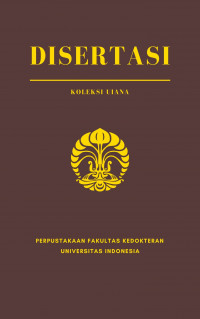Disertasi
Mekanisme Molekuler Respons Adaptasi Terhadap Pajanan Kronis Radiasi Latar Tinggi Alamiah Pada Penduduk Mamuju: Tinjauan Jalur Inflamasi dan Stres Oksidatif. = The molecular mechanism of a radioadaptive response induced by chronic high natural background radiation exposure in the inhabitants of Mamuju (West Sulawesi): inflammatory and oxidative stress perspectives.
Latar Belakang: Penelitian yang dilakukan bertujuan untuk mengetahui secara lebih mendalam mekanisme molekuler fenomena respons adaptasi pada penduduk Mamuju, Sulawesi Barat sebagai area radiasi latar tinggi (high background radiation area/HBRA) di Indonesia khususnya ditinjau dari jalur inflamasi dan stress oksidatif. Metode: Penduduk Dusun Tande-Tande, Mamuju sebagai area radiasi latar tinggi dan penduduk Desa Topoyo, Mamuju Tengah sebagai kelompok kontrol direkrut dalam penelitian. Pemeriksaan kerusakan DNA, aberasi kromosom tidak stabil, stabil, mikronukleus, indeks mitosis, nuclear division index, aktivitas enzim SOD, GPx konsentrasi CAT serum dan darah lengkap dilakukan pada penelitian. Analisis G2 MN dilakukan untuk memvalidasi respons adaptasi pada penduduk Dusun Tande-Tande. Pengukuran konsentrasi sitokin dan protein pro-inflamasi, antiinflamasi, p-Akt, Akt, dan NFkB dilakukan untuk mengetahui keterlibatan jalur inflamasi dan stress oksidatif pada fenomena respons adaptasi. Hasil: Analisis kerusakan DNA, aberasi kromosom tidak stabil, stabil, aktivitas SOD, aktivitas GPx menunjukkan tidak terdapat perbedaan yang bermakna antara kedua kelompok penelitian. Rerata konsentrasi CAT kelompok kasus lebih rendah secara bermakna dibandingkan kelompok kontrol. Nilai indeks mitosis dan nuclear division index (NDI) pada kelompok kasus lebih tinggi secara bermakna dibandingkan kelompok kontrol. Rerata konsentrasi sitokin proinflamasi dan antiinflamasi pada serum kelompok kasus lebih rendah secara bermakna dibandingkan kelompok kontrol. Rerata konsentrasi protein marker inflamasi CRP pada serum kelompok kasus lebih rendah tetapi tidak bermakna secara statistik dibandingkan kelompok kontrol. Hasil pemeriksaan darah lengkap memperlihatkan bahwa jumlah sel darah merah kelompok kasus lebih tinggi secara bermakna sedangkan jumlah limfosit, nilai MCV, MCH, MCHC, dan RDW kelompok kasus lebih rendah secara bermakna dibandingkan kelompok kontrol. Rerata nilai rasio p-Akt/Akt dan konsentrasi NFkB kelompok kasus lebih rendah secara bermakna dibandingkan dengan kelompok kontrol. Kesimpulan: Fenomena respons adaptasi terhadap radiasi terjadi pada penduduk Dusun Tande-Tande, Mamuju. Hasil penelitian belum dapat membuktikan peningkatan antioksidan serta sitokin tertentu baik sitokin pro maupun antiinflamasi pada kelompok kasus. Aktivasi jalur Akt dan NFkB pada kelompok kasus belum dapat dibuktikan mengingat nilai rasio p-Akt/Akt serta konsentrasi NFkB lebih rendah secara bermakna dibandingkan dengan kelompok kontrol.
Kata kunci: Inflamasi, Mamuju, Radiasi dosis rendah, Respons adaptasi, Stres oksidatif.
Background: This study aim is to investigate the molecular mechanism of radioadaptive response in inhabitants ofMamuju, West Sulawesi as one of the high background radiation areas of Indonesia, particularly from inflammatory and oxidative stress perspectives. Methods: Tande-Tande sub-village, Mamuju district inhabitants as high background radiation areas, and Topoyo Village inhabitants in Middle Mamuju district were recruited in this study. Evaluation of DNA damage, unstable and stable chromosomal aberrations, micronucleus, mitotic index, nuclear dividon index, SOD and GPx activities, serum catalase concentration and complete blood count were performed in this study. The G2 MN assay for validating the radioadaptive response phenomenon was performed in this study. Measurement of pro and antiinflamamatory cytokines, p-Akt, AKt and NFkB were performed to find out the involvement of infllmation and stress oxidative on radioadaptive response phenomenon. Results: The levels of DNA damage and stable and unstable chromosomal aberrations were not significantly different between the two groups. The rate of cell proliferation represented by the mitotic and nuclear dividion indexes showed a significantly higher rate in the case group. The SOD and GPx activities were not significantly different between the two groups. Interestingly, the CAT concentration was significantly lower in the case group. A significant lower level of both pro- and anti-inflammatory cytokines was also found in the case group. A lower level of CRP concentration as an inflammatory marker protein also showed in the present study, although it was not statistically significant. The complete blood counts analysis revealed a significant increase in RBC numbers and a significant decrease in lymphocyte numbers (MCV, MCH, MCHC, and RDW values) in the case group. The p-Akt/Akt ratio and NFkB concentration were also found to be statistically lower in the case group. Conclusion: It can be concluded that the radioadaptive response phenomena induced by chronic low radiation dose exposure existed in Tande-Tande sub-village inhabitants. However, this present study failed to find a significant increase of antioxidant enzymes and inflammatory cytokines in Tande-Tande sub-village inhabitants. The activation of Akt and NFkB pathways in Tande-Tande sub-village inhabitants was also not found in this present study.
Keywords: Adaptive response, Inflammation, Low dose radiation exposure, Mamuju, Oxidative stress.
- Judul Seri
-
-
- Tahun Terbit
-
2023
- Pengarang
-
Dwi Ramadhani - Nama Orang
Septelia Inawati Wanandi - Nama Orang
Heri Wibowo - Nama Orang
Mukh Syaifudin - Nama Orang - No. Panggil
-
D23007fk
- Penerbit
- Jakarta : Program Doktor Ilmu Biomedik., 2023
- Deskripsi Fisik
-
-
- Bahasa
-
Indonesia
- ISBN/ISSN
-
-
- Klasifikasi
-
NONE
- Edisi
-
-
- Subjek
- Info Detail Spesifik
-
Tanpa Hardcopy
| D23007fk | D23007fk | Perpustakaan FKUI | Tersedia |


Masuk ke area anggota untuk memberikan review tentang koleksi